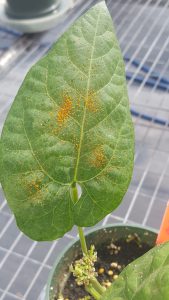| Highlights
· Thrips can cause significant damage to greenhouse plants, and biological control options are becoming increasingly popular for growers. · Sustaining biological control agent populations beyond initial release in a greenhouse can be challenging. · New UF/IFAS research investigates how to manage poinsettia thrips with predatory thrips and how to keep the predators alive for several life cycles. |
Predatory insects are used to help manage a variety of greenhouse pests. Keeping these arthropods’ voracious appetites in check can be difficult, and their long-term survival is important to successful pest management. New UF/IFAS research provides management strategies to help biological control agent populations thrive.
“There is a growing concern over the use of chemical pesticides for pest management, which has led to an increased interest in using predatory and parasitic insects to manage greenhouse pests,” said Erich Schoeller, UF/IFAS postdoctoral researcher.
“Unfortunately, we lack great alternatives to chemical control options for many greenhouse pests. It is often a game of trial and error to figure out the best predator to deal with a particular pest. Something that works great for one pest might not work for another.”
There are thousands of thrips species that feed on plants. This study investigated ways to manage Echinothrips americanus, also known as poinsettia thrips, a globally important pest of many crops grown in greenhouses.
“Thrips are a particularly big problem for greenhouses, and poinsettia thrips are a pretty large thrips species,” said Schoeller. “We were looking for a really large predator for a really large pest.”
The research team studied Franklinothrips vespiformis Crawford which is a generalist predator with a large appetite.
“I was surprised by how effective this predator was in just a short time,” said Schoeller. “We went from high densities of the pests to almost nothing in just two weeks of having released the predatory thrips.”
These results were seen in many crops including kava, poinsettia, and industrial hemp.
The predator’s intense appetite is great for controlling pests, but once they have eaten all available prey within the greenhouse, they often die of starvation. Researchers wanted to know if they could feed the insect a supplemental diet of brine shrimp eggs, or cysts, to sustain their populations during times of low prey populations.
Many studies over the years have tested this method by feeding the predators pollen, other insect eggs and artificial diets, but many of the diets tested are too expensive for large-scale operations to implement.
Brine shrimp eggs are commercially available and often used as fish food. They have been tested globally as a supplemental food for biological control agents with some consistent positive results in the past five years. However, scientists had not tested the suitability of a brine shrimp egg diet on this species of predator.
 Turns out, thrips do like the eggs. But not just any brine shrimp eggs will work. The cysts used are specially processed and sold by a commercial insectary in Israel. Once the pest populations had been consumed by the predatory thrips, researchers saw them complete additional generations only when the supplemental food source was provided.
Turns out, thrips do like the eggs. But not just any brine shrimp eggs will work. The cysts used are specially processed and sold by a commercial insectary in Israel. Once the pest populations had been consumed by the predatory thrips, researchers saw them complete additional generations only when the supplemental food source was provided.
“The exciting thing is that we proved that we could keep these predators in the greenhouse longer by feeding them,” Schoeller said.
This saves money for growers, so they do not have to repeatedly buy predators. It is more affordable to feed the insects than to build a new colony. However, growers do not have much access to these predators. The predatory thrips are not commercially produced yet, but UF/IFAS entomologists at the Mid-Florida Research and Education Center in Apopka are working on ways to make them more available.
“We hope to find a way to mass rear them, using the same feeder methods used in this research,” said Schoeller. “Now that we know how to feed them in an economical way, this is a possibility.”
Researchers hope to perfect the feeding process. Currently, the diet is spread across the crops inside the greenhouse. This not only is labor intensive, but in humid climates the presence of food on the crop for long periods can cause it to mold.
“We’re fine-tuning how we feed these predators because our current process is not ideal,” Schoeller said. “We think we have a solution to this problem by creating feeder stations within the greenhouse so that supplemental food does not need to be directly applied to the crop, but we’re still working on that.”
More good news — in additional research trials, these predatory thrips show potential for controlling other pests including whiteflies, spider mites and chilli thrips.
“Knowing how to raise these predators is helpful, especially since we see that they have the potential for controlling other pests beyond our study species,” said Schoeller. “This is really exciting for the future.”
This work was a collaboration between UF/IFAS entomologist Lance Osborne, USDA research entomologist Cindy McKenzie and funded by the Floriculture and Nursery Research Initiative, USDA APHIS, Farm Bill and Osborne’s NIFA Research Project Invasive Species Management on High Valued Crops Grown in Protected Culture.
 0
0
